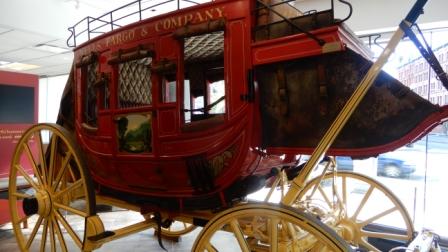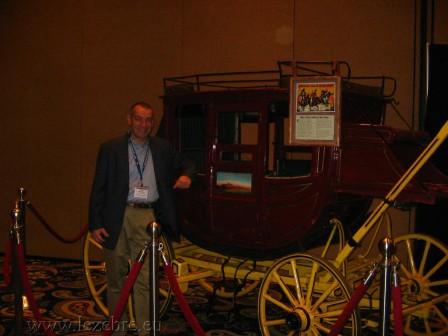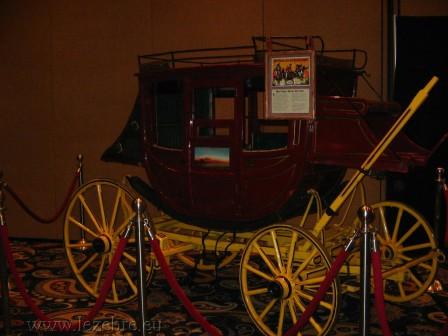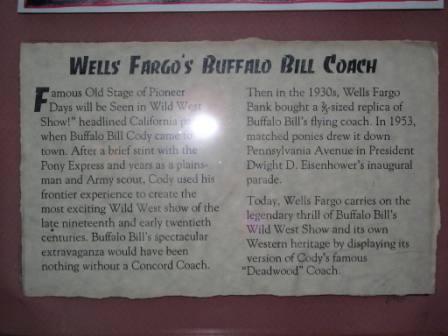

| site search byfreefind | |||
|
|||
Wells Fargo Concord Stagecoach
The replica: Master Stagecoach builder J.Brown built his stagecoach from measured drawings of original Concord Coaches crafted one hundred and fifty years ago. This coach is an accurate replica of stages ordered by Wells Fargo & Company in 1868 from the Abbot-Downing Company of Concord, New Hampshire.
Below: Wells Fargo Stagecoach from the Wild West Show with Buffalo Bill. 1930 2/3 replica.
The original: meticulously crafted of the finest materials in Concord, New Hampshire, Wells Fargo Stagecoaches featured strong, egg-shaped hardwood coach bodies suspended on leather thoroughbraces, which acted as shock absorbers and far less jarring than coaches with steel springs.
Wells Fargo ordered its coaches painted red and yellow, still the signature of Wells Fargo & Company. The distinctive rounded wooden body of each Concord coach rested on leather straps called thoroughbraces, a unique suspension system that served as shock absorbers and that provided a rocking ride.
From 1866 to 1869, Wells Fargo operated major overland stage route west of the Missouri River, spanning 2,500 miles of territory from California to Nebraska. Wells Fargo stagecoaches connected eastern states with western states and territories, uniting our nation by bridging the gap between the unfinished ends of the transcontinental railroad.
Even as railroads expanded across the nation, stagecoaches still provided essential transportation and connected many communities. Stage also delivered mail and newspapers, keeping Americans informed and in touch since the earliest days of the Republic.
Stagecoaches averaged speeds of five to twelve miles an hour and stopped only to change horses and to allow drivers and passengers a quick meal at taverns or stage stations along the route. Coaches often accommodated up to nine passengers inside. Three sat in the middle on a bench-like jumpseat that folded up to allow for easy entry and exit.
Passengers paid $8 for a stagecoach ticket from Washington to Philadelphia in 1802. Departing the nation's capital at 2pm, travelers arrived in Philadelphia in time for dinner-the next day.
Red and gold: Wells Fargo stagecoaches were painted a familiar red with the company name in gold leaf.
Top railing: although made to carry luggage, the roof often provided extra seating for as many as nine passengers.
Leader curtains: oiled leather curtains helped keep the dust, wind and rain out of the stagecoach.
Driver's box and shotgun seat: the driver handled the reins of a team of four and six horses. The Wells Fargo shotgun messenger kept an eye out for bandits and protected the Wells Fargo treasure in the front boot.
Foot brake: the driver operated the brake lever by foot.
Wheels: the wheels and running gear of the stagecoach were painted a bright straw yellow.
The wooden leather lined brake shoes locked the wheels and helped halt the stagecoach.
Tires: a circular iron band was expanded by heat and set around a wooden rim, then plunged in cold water to shrink it securely in place.
Spokes: made of hand-hewn hickory, every spoke was the exact same weight and measurement to ensure perfect balance. The spokes were long enough to get through the mud and rutted roads.
Lewis Downing, a wheelwright from Lexington, Mass., arrived in Concord in 1818 with a set of tools and $60 in his pocket. Downing was endowed with courage and optimism and made his first carriage for Benjamin Kimball. Downing prospered as a wheelwright, setting up a small factory that had more than a dozen employees. He joined forces with carriage builder J. Stephen Abbot in 1826, and the first Concord Coach was built in the following year.
The coaches were tall and wide, custom made and individually numbered, weighing 2,500 pounds each.
Mark Twain, described his coach trip west in the 1870 book Roughing it: “Our coach was a great swinging and swaying stage, of the most sumptuous description – an imposing cradle on wheels. It was drawn by six handsome horses, and by the side of the driver sat the ‘conductor,’ the legitimate captain of the craft; for it was his business to take charge and care of the mails, baggage, express matter, and passengers. We sat on the back seat, inside. About all the rest of the coach was full of mail bags – for we had three days’ delayed mails with us… We changed horses every ten miles, all day long, and fairly flew over the hard, level road.”
The cost was between $1,000 and $1,500 a piece, when a worker considered a dollar a day a good wage. Coaches had separate models to carry six, nine and 12 passengers. Abbot-Downing’s biggest customer was Wells, Fargo & Co., although institutions such as hotels would buy one to carry guests back and forth from a railroad station.
Abbot-Downing survived into the 20th century, and in 1915, the manufacturer supplanted its horse-drawn products with trucks and fire trucks powered by internal combustion engines. The company stopped manufacturing after World War I and the name was purchased by Wells, Fargo.
Credits: Wells Fargo and Concord Historical Society





